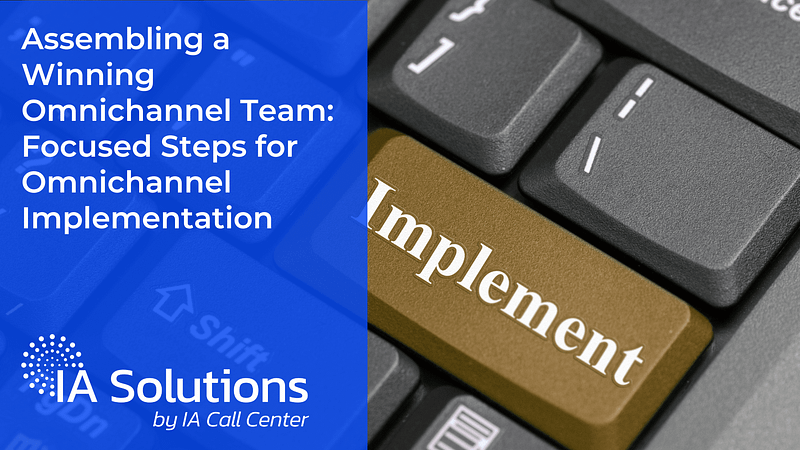Assembling a Winning Omnichannel Team: Focused Steps for Omnichannel Implementation.
Rather listen to the BlogCast for this post instead? Click the “Play” button below to hear it now.
Introduction
In today’s rapidly evolving digital landscape, businesses are increasingly recognizing the importance of offering a seamless omnichannel customer experience. More and more, implementing an omnichannel strategy is critical for meeting the heightened expectations of today’s consumers and achieving a competitive edge in the marketplace. This article, “Assembling a Winning Omnichannel Team: Focused Steps for Omnichannel Implementation”, guides you through the complexities of adopting an omnichannel approach, highlighting actionable insights, strategic planning, and execution with the support of real-world data.
The shift toward omnichannel retailing and customer experience is not just a trend but a fundamental change in the way businesses interact with consumers. Consequently, this transformation requires a meticulous approach, starting with a clear understanding of the goals and the steps necessary for successful implementation. An effective omnichannel strategy and implementation enhances customer satisfaction, increases loyalty, and drives sales by providing a cohesive experience, whether the customer is shopping online from a mobile device, a laptop, or in a brick-and-mortar store.
Preparing for Omnichannel Implementation
As with most things, preparation is key to successfully completing the steps for omnichannel implementation. This initial phase involves assessing the current state of your business’s digital and physical channels and aligning them with your omnichannel vision.
Setting Up the Core Omnichannel Infrastructure
Establishing a robust omnichannel infrastructure is essential for supporting the seamless integration of various channels and touchpoints.
Technical Assessment and Upgrades
Evaluating and upgrading existing systems to meet omnichannel requirements is paramount, as it helps to ensure they are scalable and flexible enough to adapt to changing business needs and customer expectations. In fact, a survey by Gartner highlighted that nearly 87% of business leaders prioritize scalability in their technology investments to support future growth.

Ensuring Scalability and Flexibility
An Adobe’s Digital Economy Index report shows a 58% increase in online shopping levels over pre-pandemic levels, demonstrating the critical need for businesses to have scalable and flexible systems that can handle surges in online activity and integrate new channels as consumer behaviors evolve.
Seamless Integration Across Channels
Seamless integration is another cornerstone in completing the steps for omnichannel implementation and success. For instance, a study by IDC found that businesses using integrated cloud services saw a 67% improvement in customer satisfaction, as these platforms facilitate the seamless flow of data across channels, enabling a unified view of the customer journey.
Integrating Channels and Touchpoints
Integrating digital and physical channels ensures a cohesive customer journey, enhancing the overall shopping experience.
Comprehensive Customer Journey Mapping
Mapping the entire customer journey across all touchpoints used by your company is crucial. According to research from Forrester, companies that excel in customer journey mapping are 80% more likely to report revenue growth than their peers, showcasing the importance of understanding and optimizing each step of the customer’s path.
Optimizing the Customer Experience Across Touchpoints
Additionally, leveraging insights from journey mapping to improve interactions at every touchpoint can significantly increase customer loyalty. A Harvard Business Review study revealed that omnichannel customers spend an average of 4% more in-store and 10% more online than single-channel customers.
Leveraging Personalization to Enhance Engagement
Data-driven personalization is another powerful tool that is useful in successfully completing the steps for omnichannel implementation and/or retailing. Take, for instance, a Salesforce report that shows 84% of customers believe being treated like a person, not a number, is crucial to winning their business. This number highlights the value of personalized experiences based on customer data analytics.

Technical Implementation Steps
Transitioning to a technically integrated omnichannel approach involves selecting the right platforms and ensuring seamless data synchronization across channels. Therefore, choosing and deploying suitable omnichannel platforms and tools is vital for enabling integrated customer engagement.
Platform Selection
Selecting omnichannel platforms requires that they be able to integrate smoothly with your existing systems and sufficient scalability to accommodate future growth.
Technical Readiness
Your business must prepare its IT infrastructure for integrating new solutions, ensuring compatibility and minimal disruption to ongoing operations. Additionally, you must ensure new solutions can seamlessly integrate with current systems in order to leverage existing technology investments and facilitate a smooth transition to omnichannel operations.
Data Synchronization and Management
A unified customer experience requires effective management and synchronization of data across channels. Therefore, here are a few insights on how to accomplish this:

Real-Time Data Synchronization
When focusing on completing the steps for omnichannel implementation, utilize solutions that ensure up-to-date customer information across all touchpoints. This is key to maintaining a consistent and personalized customer experience. Real-time data synchronization enables your business to respond swiftly to customer actions and preferences, which enhances engagement and satisfaction.
Ensuring Data Accuracy and Privacy
With concerns over data privacy increasing every day, your business must adhere to strict data management practices. Therefore, compliance with regulations like GDPR and implementing robust security measures is a must in order to safeguard customer information and build trust.
Leveraging Data for Personalization
Leveraging advanced analytics enables your business to create targeted marketing campaigns and personalized shopping experiences based on customer data insights. Successful completion of the steps for omnichannel implementation includes strategies that rely heavily on personalization to boost customer engagement and drive sales.
Next Steps
The preparation and technical implementation stages are crucial for establishing a successful omnichannel strategy. By emphasizing infrastructure, channel integration, and data-driven personalization, businesses can deliver a seamless and engaging customer experience on all platforms. To ensure a seamless transition and completion of the steps for omnichannel implementation, the next phases include training and empowering teams, establishing support structures, and planning the launch carefully.
Training and Support for Omnichannel Success
Adopting an omnichannel approach goes well beyond just integrating technology. Additionally, it involves addressing the human aspect of your business operations. Your team’s training and support are essential for reaching your omnichannel objectives.

Empowering Your Team for Omnichannel Excellence
The success of an omnichannel strategy relies heavily on its team. An empowered team can tackle the complexities of omnichannel implementation with efficiency and innovative approaches.
Customized Training Programs
Tailored training initiatives are crucial for providing your team with the essential expertise and understanding. For instance, a key factor in Best Buy’s triumphant omnichannel transformation is their emphasis on training their staff in both sales and technical support. As a result, customer satisfaction scores have skyrocketed by over 40%.
Ongoing Education and Support
The ever-changing digital landscape requires continuous education and support for your team to keep up. Continuous learning empowers your team to stay at the forefront of omnichannel trends and technologies, enabling them to adapt and innovate as needed.
Fostering an Omnichannel Mindset
Embracing omnichannel principles is crucial for fostering a culture that seamlessly integrates different channels. By promoting collaboration across departments and prioritizing a customer-centric approach, you can greatly improve the effectiveness of your omnichannel strategy.
Establishing Support Structures
Support structures are crucial not only during the initial transition but also for the ongoing success of your omnichannel strategy.
Technical Support Teams
Dedicated technical support teams are a must for promptly resolving system-related challenges and ensuring smooth operations. This approach guarantees that your omnichannel platforms will stay up and running, ensuring a seamless customer experience with no disturbances.
Customer Service Excellence
By adopting an omnichannel approach to customer service, your business can greatly increase customer satisfaction levels. Furthermore, the integration of customer service channels ensures a consistent and efficient support experience for your customers, regardless of their preferred method of communication or interaction.
Go-Live and Initial Monitoring
The go-live phase is a critical juncture in your omnichannel journey, signifying the shift from careful planning and preparation to carrying out the remaining last steps for omnichannel implementation. A smooth launch is contingent upon careful management and real-time monitoring during this phase.

Executing the Launch Plan
A meticulously planned launch is essential for the successful deployment of your omnichannel strategy. With that in mind, here are some ideas to help you with a successful omnichannel launch:
Communication Plan
Effective communication with all stakeholders is an absolute must, as it ensures clear understanding and alignment among customers, staff, and partners. Providing clear messaging about what to expect during and after the go-live can effectively manage expectations and minimize any resistance to change.
Phased Rollout
By implementing a phased rollout, your team can address any unforeseen issues and resolve them on a smaller scale before a full-scale launch. This approach also minimizes risk while offering valuable insights to guide and manage the finals steps for omnichannel implementation.
Monitoring and Initial Adjustments
Immediate monitoring following the launch of your omnichannel implementation provides insights into the performance of your omnichannel strategy and identifies areas for improvement. Here are some tips for making your monitoring efforts successful.
Real-Time Monitoring
Use analytics and monitoring tools to gain immediate insights into system performance and customer interactions. This invaluable data allows for informed decisions and adjustments during the early stages of the launch.
Feedback Loops and Continuous Improvement
Develop systems to gather and evaluate input from both customers and staff members. This feedback can provide valuable insights that will help you fine-tune and optimize your omnichannel strategy, ensuring it continues to meet customer needs and align with business goals.
Conclusion
In conclusion, to successfully implement an omnichannel strategy, you need to engage in comprehensive planning, integrate technology and channels seamlessly, and empower your team. With careful adherence to the detailed steps outlined in this guide and leveraging tangible real-world data and insights, your business can effectively maneuver through the intricate landscape of omnichannel implementation. By successfully implementing an omnichannel strategy, you can greatly improve customer satisfaction, optimize operations, and foster growth, positioning your business for success in today’s digital marketplace.

Summary
To reach omnichannel excellence, your company must navigate a complex path that involves strategic preparation, seamless technological integration, empowering teams, and ongoing monitoring and optimization. Your business can achieve a seamless and captivating omnichannel presence through dedicated effort, a clear vision, and a commitment to ongoing improvement. This approach not only keeps up with the shifting demands of modern consumers, but also creates the perfect conditions for continued prosperity in the digital age.
Coming Up Next
In the next installment of our “Assembling a Winning Omnichannel Team” series, we will discuss the critical phase of measuring goals and metrics to evaluate the success of your omnichannel strategy and implementation.
After deploying an omnichannel approach, it’s also important to understand whether your efforts are bearing fruit and aligning with the initial objectives set forth during the planning stages. This next step is all about quantifying the impact of your omnichannel strategy on customer experience, operational efficiency, and, ultimately, business growth.
Furthermore, in our next post, we’ll explore the key performance indicators (KPIs) that your business needs to monitor, from customer engagement metrics like Net Promoter Score (NPS) and customer retention rates to important operational metrics. Additionally, we’ll cover how to leverage analytics tools to gather actionable insights, which enable your team to make informed decisions and iterate on your strategy for continuous improvement.
After all, through a thoughtful analysis of these metrics, your business can pinpoint areas of success, identify opportunities for enhancement, and ensure that your omnichannel strategy remains dynamic and responsive to changing market conditions and consumer behaviors.















